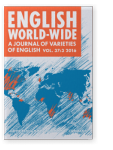Familiarity, comprehension and use of Indian English only
L1 Indian English speakers’ psycholinguistic judgments and interview responses
Indian English only (IndE-only), e.g. “I’ll meet you here only”, is rejected as poor English by many IndE speakers. In the present study, we used a mixed method to investigate familiarity, comprehension and use of IndE-only in 20 L1 IndE speakers in the US. Participants completed a psycholinguistic task comprising syntactic, semantic, and pragmatic judgments of IndE, standard English, and grammatically or semantically odd control sentences. L1 IndE speakers’ task performance was compared to a control group of 33 American English speakers. Results showed that IndE speakers were familiar with syntactic aspects of IndE-only consistent with the literature, and were able to extract significantly more information about implicatures and conversational contexts compared to the control group. L1 IndE speakers were also interviewed about their attitudes towards IndE and IndE-only. Qualitative results indicated that despite some stigmatization, mostly in the written form, IndE-only exemplifies the emerging identity of L1 IndE.
References (26)
Agnihotri, Rajesh K
1999 “
India: English in India.” In
Rajendra Singh, ed.
The Yearbook of South Asian Languages and Linguistics. New Delhi: Sage Publications, 184–198.

Asher, R.E
1985 Tamil. Amsterdam: Croom Helm.

Balasubramanian, Chandrika
2009 “
Circumstance Adverbials in Registers of Indian English.”
World Englishes 281: 485–508.


Bao, Zhiming
2003 “
Social Stigma and Grammatical Autonomy in Nonnative Varieties of English”.
Language in Society 321: 23–46.



Bhatt, Rakesh M
2000 “
Optimal Expressions in Indian English.”
English Language and Linguistics 41: 69–95.


Bhatt, Rakesh M
2004 “
Indian English: Syntax.” In
Bernd Kortmann,
Kathryn Burridge,
Rajend Mesthrie,
Edgar W. Schneider and
Clive Upton, eds.
Handbook of Varieties of English 2: Morphology and Syntax. Berlin: Mouton de Gruyter, 1016–1030.

Crystal, David
2004, “
Subcontinent Raises its Voice.”
The Guardian 19 November 2004 <
[URL] (accessed November 21, 2014).

Desai, Sonalde, Amaresh Dubey, Brij Lal Joshi, Mitali Sen, Abusaleh Shariff, and Reeve Vanneman
2010 Human Development in India. New Delhi: Oxford University Press.

Jenkins, Jennifer
2015 Global Englishes: A Resource Book for Students (3rd ed.). New York: Routledge.

Kachru, Braj B
1976 “
Models of English for the Third World: White Man’s Linguistic Burden or Language Pragmatics.”
Tesol Quarterly 101: 221–239.


Kachru, Braj B
1983 The Indianization of English: The English Language in India. Oxford: Oxford University Press.

Marian, Viorica, Henrike K. Blumenfeld, and Margarita Kaushanskaya
2007 “
The Language Experience and Proficiency Questionnaire (LEAP-Q): Assessing Language Profiles in Bilinguals and Multilinguals.”
Journal of Speech, Language, and Hearing Research 501: 940–967.


Labov, William
1972 Sociolinguistic Patterns. Philadelphia: University of Pennsylvania Press.

Mukherjee, Joybrato
2007 “
Steady States in the Evolution of New Englishes: Present-Day Indian English as an Equilibrium.”
Journal of English Linguistics 351: 157–187.


Pandharipande, Rajeshwari V
1997 Marathi. London: Routledge.

Parviainen, Hanna
2012 “
Focus Particles in Indian English and Other Varieties.”
World Englishes 311: 226–247.


Schneider, Edgar W
2007 Postcolonial English: Varieties around the World. Cambridge: Cambridge University Press.


Sharma, Devyani
2003 “
Discourse Clitics and Constructive Morphology in Hindi.” In
Miriam Butt, and
Tracy H. King, eds.
Nominals Inside and Out. Stanford: CSLI Publications, 59–84

Sharma, Devyani
2005 “
Dialect Stabilization and Speaker Awareness in Non-Native Varieties of English.”
Journal of Sociolinguistics 91: 194–224.


The International Corpus of English: India
2002 Department of English, Shivaji University, Kolhapur and Freie Universität, Berlin.

Trudgill, Peter
1986 Dialects in Contact. Oxford: Blackwell.

Wheeler, Jil
2009 “
It’s Like This, Only.”
The Morning News May 28 2009 <
[URL] (accessed November 21, 2014).

Cited by (2)
Cited by 2 other publications
Aishwarya, N. & D. Ruth Deborah
2021.
Comparison of Narrative Comprehension and Inference-Making Ability in Native Tamil Speakers in Monolingual and Bilingual Context.
Journal of Research in Childhood Education 35:4
► pp. 616 ff.

Parviainen, Hanna & Robert Fuchs
2019.
‘I don’t get time only’: an apparent-time investigation of clause-final focus particles in Asian Englishes.
Asian Englishes 21:3
► pp. 285 ff.

This list is based on CrossRef data as of 2 july 2024. Please note that it may not be complete. Sources presented here have been supplied by the respective publishers.
Any errors therein should be reported to them.
